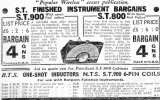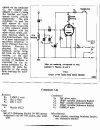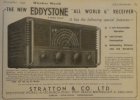Never realised it was also called the creeping unknown. Just started to watch it on you tube, couldn't stop laughing.Quatermass II not the first series.
-
Welcome to this forum . We are a worldwide group with a common interest in Birmingham and its history. While here, please follow a few simple rules. We ask that you respect other members, thank those who have helped you and please keep your contributions on-topic with the thread.
We do hope you enjoy your visit. BHF Admin Team
You are using an out of date browser. It may not display this or other websites correctly.
You should upgrade or use an alternative browser.
You should upgrade or use an alternative browser.
Early Radio
- Thread starter Old Boy
- Start date
cookie273uk
Gone but not forgotten
nickcc 101 , Like you I found it more comical than creepy and had a good laugh, but there again I used to laugh at Boris Karloff's so called 'horror' films. I must have a weird sense of humour' Eric
Not necessarily, some of the old Roger Corman films were definitely played for laughs.nickcc 101 , Like you I found it more comical than creepy and had a good laugh, but there again I used to laugh at Boris Karloff's so called 'horror' films. I must have a weird sense of humour' Eric
Radiorails
master brummie
My home had a very good radio which also had a record turntable at the top accessed by a hinged top. It was about the size and shape of a washing machine, of stylish appearance and had a good radio which gave me access to short wave bands as well as the European based long and medium wavebands.
I found that an antenna could enhance my listening and I heard very many interesting stations which gave me the impetus of becoming what was known as a short wave listener. Over the years I won prizes having entered competition run by overseas radio stations. I eventually took my examination to become a radio ham and have spoken with many peoples world wide. Most of the present day electronic things - such as mobile phones, internet and so on were pioneered by radio hams over the years. It is much easier to become a ham today than years ago as the technical written exams were replaced by multiple choice style exam papers. Furthermore most radio transmitter/receivers are 'ready to go' more or less and are far more expensive that the kits and home built equipment many made in the past - some die hards still do of course.
I found that an antenna could enhance my listening and I heard very many interesting stations which gave me the impetus of becoming what was known as a short wave listener. Over the years I won prizes having entered competition run by overseas radio stations. I eventually took my examination to become a radio ham and have spoken with many peoples world wide. Most of the present day electronic things - such as mobile phones, internet and so on were pioneered by radio hams over the years. It is much easier to become a ham today than years ago as the technical written exams were replaced by multiple choice style exam papers. Furthermore most radio transmitter/receivers are 'ready to go' more or less and are far more expensive that the kits and home built equipment many made in the past - some die hards still do of course.
ChrisM
Gone but not forgotten R.I.P
Alan's comment about the radio with the record turntable on top reminds me of my own experience with a similar bit of kit.
When I was a small boy during the war I was taken to visit an aunt who lived in a vast house on the Bristol Road. She had a pre-war radiogram with an autochange on it and this was demonstrated to me. I was spellbound as the arm moved out of the way, the next record thumped down, the arm found its way back to the correct position and a different piece of music blared forth. I had never, ever, seen anything like it.
"Auntie", I remember crying excitedly, "How does it do it - how DOES it do it?"
She looked at me knowingly as I awaited an explanation to this miracle. I felt that the wonders of the Universe were about to be revealed to me.
"Ah", she said, "It's the MECHANISM".
I was bitterly disappointed at the time, and remain so to this day, at the total inadequacy of this response. But it was all I ever got.
Chris
When I was a small boy during the war I was taken to visit an aunt who lived in a vast house on the Bristol Road. She had a pre-war radiogram with an autochange on it and this was demonstrated to me. I was spellbound as the arm moved out of the way, the next record thumped down, the arm found its way back to the correct position and a different piece of music blared forth. I had never, ever, seen anything like it.
"Auntie", I remember crying excitedly, "How does it do it - how DOES it do it?"
She looked at me knowingly as I awaited an explanation to this miracle. I felt that the wonders of the Universe were about to be revealed to me.
"Ah", she said, "It's the MECHANISM".
I was bitterly disappointed at the time, and remain so to this day, at the total inadequacy of this response. But it was all I ever got.
Chris
sospiri
GONE BUT NOT FORGOTTEN
I think that was my father's favourite pastime - going around the secondhand radio shops seeing the best radio he could get for the money, though he never ventured into buying records or record players. Some of them lasted only a few months before he tired of them and found something better, but the one that outlasted the lot was the Pye QAC5, long, medium and three short wave bands. The upper of those three bands covering 30 to 49 MHz didn't produce a squeak - without tuned aerials and a new set of valves it was never likely to. But after Dad passed away and when Mom was out at work at Lucas or the greyhound tracks it gave me endless hours of pleasure. The schematic is still available on the internet, though the receiver was scrapped years ago!
Maurice
Maurice
ChrisM
Gone but not forgotten R.I.P
My father not only built his own radio in the early 1920s but also the oak cabinet in which to accommodate it. This piece of freestanding furniture was big enough to be converted into a cocktail cabinet in later years and survives to this day: with doors removed it accommodates my printer and scanner. In about six years time it will celebrate its 100th birthday and will have witnessed a fair bit of progress in technology in that time.
Chris
Chris
jukebox
Engineer Brummie
In the early 60s (IIRC) the BBC experimented with stereophonic broadcasting using a TV as one channel and a radio as the other. The stereo effect was certainly noticeable but not perfect as for good separation the speakers needed to be matched and in phase. I think the experiments were done on a Saturday morning before the scheduled TV broadcasts went on air. Does anyone else remember this?
oldMohawk
gone but not forgotten
Yes I remember it and listened to it. I can remember having to sit positioned centrally between the speakers to hear the stereo correctly. These days I don't bother where I sit ... I just listen to the music ...In the early 60s (IIRC) the BBC experimented with stereophonic broadcasting using a TV as one channel and a radio as the other. The stereo effect was certainly noticeable but not perfect as for good separation the speakers needed to be matched and in phase. I think the experiments were done on a Saturday morning before the scheduled TV broadcasts went on air. Does anyone else remember this?
Lady Penelope
master brummie
Just noticed on post 22 'BBC Dancing Club' - why would you have a dance club on the radio? Isn't it a bit like the Archie Andrews scenario?
maypolebaz
master brummie
Had our first TV for the Coronation. Remember being scared out of my wits watching Quatermass, something about silos and melted down bodies if I remember correctly.
I remember being terrified by The Quatermass Experiment too, I seem to remember somebody coming back from space and turning into a shrub. "Journey Into Space" gave me the willies as well.
I was fascinated by a series called "Victory at Sea", American footage of the war in the Pacific but terrific viewing for a kid like me. One of the beautiful lady announcers would say it would be on later in the evening and that it was not suitable for children. Our Mom would pack my kid brother and me off to bed and as soon as Derek was asleep I was allowed to tiptoe back downstairs to watch it.
Pedrocut
Master Barmmie
SynopsisJust noticed on post 22 'BBC Dancing Club' - why would you have a dance club on the radio? Isn't it a bit like the Archie Andrews scenario?
with Victor Silvester and his Ballroom Orchestra, including music for dancing and a ten-minute lesson by Victor Silvester. Introduced by Alan Clarke
https://genome.ch.bbc.co.uk/d35c0f335c3546d39377b59d194350e5
Used to love journey in to space, seem to remember them landing on Mars.I remember being terrified by The Quatermass Experiment too, I seem to remember somebody coming back from space and turning into a shrub. "Journey Into Space" gave me the willies as well.
I was fascinated by a series called "Victory at Sea", American footage of the war in the Pacific but terrific viewing for a kid like me. One of the beautiful lady announcers would say it would be on later in the evening and that it was not suitable for children. Our Mom would pack my kid brother and me off to bed and as soon as Derek was asleep I was allowed to tiptoe back downstairs to watch it.
Radiorails
master brummie
The Victor Sylvester mention makes me realize that in the past people used their imagination - and hopefully common sense - to visualize things they heard on the old 'steam' radio. The downside to that was when the BBC Radio Times magazine, or a newspaper, printed a photograph of some , who, invariably was nothing like the person that ones mind had perceived. Dick Barton aka Noel Johnson was one of these people when he was in the newspapers for speeding in his car I believe. The original Dan Archer aka Harry Oakes was also a great surprise as were many others stars of radio. I think the link below is for the Birminham Hall Green , but it does not say so. However, you have missed it as I think the play was in last July. 
https://www.behindthearras.com/reviewsam/reviewsAMapr-jul2016/dick-barton-review-hglt-HG07-16.html
I believe programmes on radio did stimulate peoples emotions and perceptions not like to day where nothing can be left to imagination and all has to be shown or explained. A dumbing down of intellect I feel.
https://www.behindthearras.com/reviewsam/reviewsAMapr-jul2016/dick-barton-review-hglt-HG07-16.html
I believe programmes on radio did stimulate peoples emotions and perceptions not like to day where nothing can be left to imagination and all has to be shown or explained. A dumbing down of intellect I feel.
Radiorails
master brummie
This gentleman, although born in South Africa, got his radio start at the BBC in Broad Street after WW2.
Perhaps about 1960 my dad fetched out the parts for an old 'wireless' that he had built in 1937, the Scott-Taggart ST900. it had been described in the magazine Popular Wireless that ceased publication that year. The dial for the set had been included as a centre spread and my dad had bought a spare copy 'in case'.
It was a strange set as the designer had turned against switches and used plugs and sockets instead. To change waveband you had to plug in a different pair of coils. To enable this the set consisted of a sloping front panel, a shelf for the coil sockets and two triangular side panels. The rear of the front panel was covered in aluminium foil, which came from the radio shop, not the grocer. We set it up on a garage workbench which allowed all the 'hot' parts to be pushed to the back away from prying hands. It worked too!
It was a strange set as the designer had turned against switches and used plugs and sockets instead. To change waveband you had to plug in a different pair of coils. To enable this the set consisted of a sloping front panel, a shelf for the coil sockets and two triangular side panels. The rear of the front panel was covered in aluminium foil, which came from the radio shop, not the grocer. We set it up on a garage workbench which allowed all the 'hot' parts to be pushed to the back away from prying hands. It worked too!

Richard Dye
master brummie
Pete, never had one of those but now I have a Sony sw/mw/lw radio and I still spend too much time listening to the jumbled up stationsmy radio was a xtal set in 1950s given to me by my grandad, the first voice i heard was david jacobs. i spent hours listening to all the jumbled up stations

My Reader's Digest Junior Omnibus reverses the polarity of D1 and omits C2. L1 consists of 60 turns of 30 swg enamelled wire on a toilet roll former, C1 is a 0.0003 μF variable capacitor, D1 a germanium diode and the earphones 2,000-4,000 ohms. For the aerial 50-100ft of wire. Quite a good article but the illustrated waveforms are wrong. The first radio that I built on my own was a Heathkit single top-hat transistor radio that needed a long aerial and 'phones. It also had an expansion kit with another transistor. Strictly bedtime listening. Paul Robeson was my favourite!my radio was a xtal set in 1950s given to me by my grandad, the first voice i heard was david jacobs. i spent hours listening to all the jumbled up stations

jukebox
Engineer Brummie
My first crystal set used a 'cat's whisker' and a crystal of galena (lead sulfide - or sulphide as it was then!!!) being before the days of germanium diodes. The galena was held in a small clamp and the cats whisker a piece of sprung wire which rested against the crystal. Getting a connection was a bit hit and miss and even a slight vibration could cause the connection to be lost. My dad eventually treated me to a germanium diode which was a lot more reliable.
mw0njm.
A Brummie Dude
oldMohawk
gone but not forgotten
My first radio was a crystal set with crystal and cats whisker and I've just noticed I posted about it in another radio thread way back in 2012 .... 
When I was little, my Dad bought me a Crystal Set radio from Chas Young's shop in Corporation St. The set had a 'cats whisker' which had to be carefully adjusted to touch a good spot on the crystal in order to hear a program.
maypolebaz
master brummie
I had a crystal set, in the early '50s. It came in a heavy bakelite case, I remember. I loved putting the earphones on and tuning odd stations in. One morning I heard a strange clanging sound and no music at all, what I heard was Big Ben chiming, continuously. Queen Mary had died.My first crystal set used a 'cat's whisker' and a crystal of galena (lead sulfide - or sulphide as it was then!!!) being before the days of germanium diodes. The galena was held in a small clamp and the cats whisker a piece of sprung wire which rested against the crystal. Getting a connection was a bit hit and miss and even a slight vibration could cause the connection to be lost. My dad eventually treated me to a germanium diode which was a lot more reliable.
How was this powerd, by a 90v battry?in the late 1950s I used 'mail-order' to buy a Globe King single valve radio kit from Johnsons Radio of Worcester. I had hours of fun building and listening to it.
View attachment 162486
Looking at the circuit I can't believe 90volts was connected to the headphones !
View attachment 162487
oldMohawk
gone but not forgotten
No, it came with parts to build the power pack for the valve anode and filament voltages.How was this powerd, by a 90v battry?



